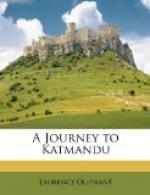The crops most generally reared are, sugar-cane, poppies, rare (a species of pulse), wheat, often with a delicate border of blue-flowered flax, tobacco, mustard, peas, and sometimes vetches. The large rose-gardens for which Ghazipore is celebrated lay to the right. I regretted that our way did not lead us through them, but we had evidence of their existence in some delicious otto of roses, which is easily procured here.
The road by which we were now travelling was what is called in India a cutcher-road, which means unmetalled. It is a pity that Government should spend so much in macadamizing roads, when cutcher-roads answer just as well for all the wants of native traffic. The rocks here are of limestone formation, and consequently, as there is not much traffic on any road in India, if the trees were cut down, roads on a limestone formation would always keep themselves in repair, provided the side drains were properly kept open. The bridges are all good, and, if the line of road was well bridged throughout, the country conveyances could always make their way along it with perfect ease. If the money now spent in macadamizing were spent in making the necessary bridges, the resources of the country would be much more fully opened out than they are at present; a garre-waller, or cart-man, can always appreciate a bridge, never a macadamized road. At present the bridges on this road are all wooden, and liable to be carried away by the first heavy flood.
The whole way to the frontier of Nepaul we travelled along a cutcher-road, accompanied by a train of at least a hundred hackerys, without the slightest inconvenience; and until the style of cart at present used by the natives becomes wonderfully improved, this road may well be used, except of course during the rains.
A few days’ march brought us to the banks of the Gograh, a large river rising in the western Terai, and measuring, at the point where we crossed, at least half a mile in breadth. As we came upon the cliff overlooking the river, the scene was novel and amusing. As 5000 persons had to reach the opposite bank, and no preparations had been made for their transit, the confusion may be easily imagined. The good-humour of the hillmen, however, was imperturbable, and, though there was plenty of loud talking, the remarks made were usually of a facetious nature.




